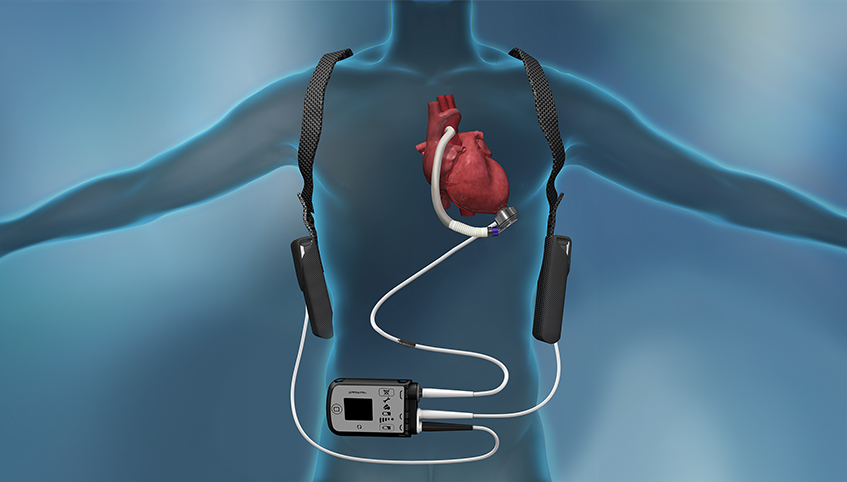Left Ventricular Assist Device (LVAD)
A left ventricular assist device (LVAD) is a mechanical pump that helps circulate blood from the ventricles (the lower chambers of the heart) throughout the body. People can need an LVAD if they've had heart failure, have weakened hearts or if they're waiting for a heart transplant.
At The University of Kansas Health System, our team of cardiac specialists has extensive experience with ventricular assist devices. We coordinate skilled heart surgeons with a team of excellent nurses and dedicated palliative care providers to ensure a positive quality of life for those who are living with an LVAD.
What is a left ventricular assist device?
Ventricular assist devices are most often placed in the left ventricle and are designed to help your heart move blood throughout the body when your heart is too weak or too injured to circulate blood properly. Ventricular assist devices are sometimes placed in the right ventricle or both ventricles, but these are typically used only when a patient is hospitalized.
Your doctor may recommend that you use an LVAD short-term, such as while you're waiting for a heart transplant or for your heart to become stronger. When an LVAD is used for only a short time while you’re waiting for a heart transplant, it’s called a bridge to transplant or BTT.
In other cases, you may need an LVAD as a long-term solution to manage heart failure. An LVAD that’s recommended for long-term use is referred to as destination therapy.
The University of Kansas Health System implants the left ventricular assist device called the HeartMate 3™ and cares for people who have earlier LVADs like the HeartMate II® and the HeartWare HVAD®. The HeartMate 3 uses Full MagLev ™ flow technology and is the latest advancement in LVAD therapy. Its use has been shown to reverse the symptoms of heart failure, improve long-term survival and provide better quality of life. Survival rate with a HeartMate 3 is now comparable to that of heart transplant at 2 years.
We offer a variety of appointment types. Learn more or call 913-588-1227 to schedule now.
Who can have a left ventricular assist device?
Your doctor will look at several factors to decide whether you’re a good candidate for an LVAD:
- Whether you can take blood-thinning medications long-term
- Whether you need assistance for the left ventricle, the right ventricle or both
- Your ability to manage life with an LVAD
- Your degree of heart failure
- Your overall health, including any other serious medical conditions
How does a left ventricular assist device work?
Your doctor will implant your LVAD during open heart surgery. The LVAD is placed so a tube connects from your left ventricle to a pump. Once the LVAD is implanted, the pump circulates blood from your ventricle to the aorta and out to the rest of your body in much the same way a heart would naturally pump.
A cable from the device passes through the skin of your abdomen and is attached to a controller and battery pack on the outside of your body. An LVAD is not the same as an artificial heart. The mechanical pump is meant to support your heart, not replace it.

Benefits and risks of a left ventricular assist device
Benefits of getting an LVAD include:
- Better quality of life
- Improved life expectancy
- Improved outcome after heart transplantation when the LVAD is used as a bridge to transplant
- Reduced heart failure symptoms
There are risks associated with an LVAD as well:
- An LVAD requires open heart surgery
- Increased risk of blood clots and stroke
- Increased risk of kidney failure
- Infection or bleeding
- Possible pump malfunction
What happens during a left ventricular assist device implantation?
Implanting an LVAD takes several hours and begins with open heart surgery. Your doctor will perform this procedure while you are under full anesthesia. You will also be placed on a heart and lung bypass machine during the surgery.
Once the LVAD is properly placed and working, you will be taken off heart and lung bypass. Following surgery, your recovery will be monitored closely. In 2022, the national average hospital stay following LVAD surgery was 26 days. At The University of Kansas Health System, our patients’ average stay is 18 days.
Why choose us for a left ventricular assist device?
The University of Kansas Health System provides the most advanced heart care tests and treatments. We are the only hospital providing heart transplant surgery in Kansas, and our hospital is a destination for those who need advanced heart failure treatment. Our comprehensive heart failure program ensures you have access to a full array of treatment options, including LVADs. We care for the sickest patients with the most complex heart issues. By choosing us for your heart care, you will:
- Benefit from our comprehensive resources, such as dietitians, social workers and palliative care providers
- Have access to a team of advanced heart failure specialists, as well as advanced practice nurses
- Have the opportunity to take part in new clinical trials for advanced heart failure
- Receive coordinated care between specialists and your primary care doctor




